The Penobscot River Restoration Project is helping to restore native fish runs of both anadromous and catadromous fish.
Anadromous fish are those species that spend the majority of their lives at sea but return to freshwater rivers, streams, and/or lakes to spawn.
There are 10 anadromous fish species native to the state of Maine:
- Alewife
- Striped bass
- Atlantic salmon
- Rainbow smelt
- Blueback herring
- American shad
- Sea lamprey
- Atlantic sturgeon S
- Shortnose sturgeon
- Atlantic tomcod
The spawning migration for each species varies, but generally occurs in May and June when fish ascend rivers to spawn in rivers or lakes and ponds. Although the adults of some species die after spawning, the majority of adult anadromous fish make their way back downstream to return to the sea shortly after spawning. The young spend the summer in the lake or river environment while preparing to migrate. Juvenile fish begin moving to the sea from mid-July through October but some stay in fresh water longer. Following a period of three to five years (the majority are at sea for four years), they return to the freshwater environments where they were hatched.
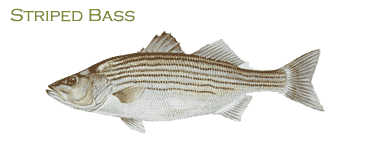 Striped Bass are dark olive green to steel blue on top, with silver colored sides and a white underbelly. On the Atlantic Coast, striped bass range from the St. Lawrence River, Canada to the St. Johns River, Florida, although they are most prevalent from Maine to North Carolina. Striped bass can weigh up to 50lbs. averaging 5-20 lbs. Striped bass are one of Maine’s most important saltwater game fish, being renowned for their powerful fight and excellent flavor. Inhabiting shallow bays, rocky shores, coastal rivers and the surf line of barrier beaches, they can be caught anytime during daylight hours but seem to be most active between sunset and sunrise. Stripers will hit a variety of baits, lures and flies. Mackerel, eels, marine worms, herring, and menhaden are commonly used baits. Proven lures include spoons, lead-headed jigs and surface and deep diving plugs.
Striped Bass are dark olive green to steel blue on top, with silver colored sides and a white underbelly. On the Atlantic Coast, striped bass range from the St. Lawrence River, Canada to the St. Johns River, Florida, although they are most prevalent from Maine to North Carolina. Striped bass can weigh up to 50lbs. averaging 5-20 lbs. Striped bass are one of Maine’s most important saltwater game fish, being renowned for their powerful fight and excellent flavor. Inhabiting shallow bays, rocky shores, coastal rivers and the surf line of barrier beaches, they can be caught anytime during daylight hours but seem to be most active between sunset and sunrise. Stripers will hit a variety of baits, lures and flies. Mackerel, eels, marine worms, herring, and menhaden are commonly used baits. Proven lures include spoons, lead-headed jigs and surface and deep diving plugs.
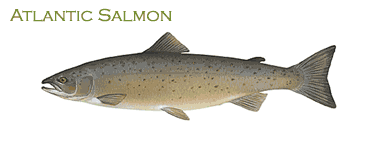 Atlantic Salmon are an anadromous species so threats to its long-term survival come in both fresh water and salt water habitats, and include habitat degradation, dams, predation, poaching, and commercial fisheries. Many saltwater sport-fishermen consider these fish to be “the king of fish” because of their great leaping ability and determined fight when hooked. In Maine, fishing for Atlantic salmon is currently prohibited, although as recent as the 1970’s angling provided tremendous recreational opportunities in the Penobscot basin and Downeast rivers, and were very important to local economies.
Atlantic Salmon are an anadromous species so threats to its long-term survival come in both fresh water and salt water habitats, and include habitat degradation, dams, predation, poaching, and commercial fisheries. Many saltwater sport-fishermen consider these fish to be “the king of fish” because of their great leaping ability and determined fight when hooked. In Maine, fishing for Atlantic salmon is currently prohibited, although as recent as the 1970’s angling provided tremendous recreational opportunities in the Penobscot basin and Downeast rivers, and were very important to local economies.
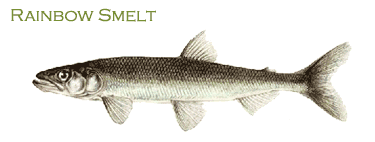 Rainbow Smelt are mostly a dark blue green with bright silver sides. These fish possess a slender body with a pointed head and deeply forked tail fin. Rainbow smelt rarely grow over 13 inches with the average adult measuring between 7 and 9 inches. In Maine, rainbow smelt are a prized food fish that are harvested in three distinct fisheries. During the summer months, as these anadromous fish move into their native streams to spawn, fishermen use dip nets to capture them. The fall season supports a riverine and coastal bay hook and line fishery. A lightweight spinning rod and reel is considered the equipment of choice for smelt. In winter, anglers fish for smelt through the ice and provide traditional entertainment for Mainers looking for a winter adventure. The winter smelt fishery supports many commercial ice fishing camps up and down the Maine coast.
Rainbow Smelt are mostly a dark blue green with bright silver sides. These fish possess a slender body with a pointed head and deeply forked tail fin. Rainbow smelt rarely grow over 13 inches with the average adult measuring between 7 and 9 inches. In Maine, rainbow smelt are a prized food fish that are harvested in three distinct fisheries. During the summer months, as these anadromous fish move into their native streams to spawn, fishermen use dip nets to capture them. The fall season supports a riverine and coastal bay hook and line fishery. A lightweight spinning rod and reel is considered the equipment of choice for smelt. In winter, anglers fish for smelt through the ice and provide traditional entertainment for Mainers looking for a winter adventure. The winter smelt fishery supports many commercial ice fishing camps up and down the Maine coast.
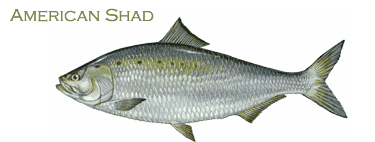
American Shad are dark blue to green above with paler sides and a silvery underbelly. American shad are the largest members of the true herring family and can grow to 30 inches in length and weigh more than nine pounds. Commonly known as “the poor man’s tarpon,” shad are highly sought after as a sport fish because of their feisty nature and their ability to leap. Almost every major river along the Atlantic seaboard historically supported a spawning population of American shad. In contrast, commercial landings have averaged less than 1,350 metric tons annually since 1980. The most popular time of the year to go shad fishing is in the spring when these fish are returning to their coastal streams and rivers to spawn.
Atlantic Tomcod is a close relative to the Atlantic cod, except much smaller (rarely over a foot long), with a life history very similar to rainbow smelt. They migrate into the lower reaches of the Penobscot and other Maine rivers during the late fall to feed and then spawn near the head of the tide in mid-winter, hence the nickname “frost fish.” By spring they migrate back to estuarine and marine areas to grow.
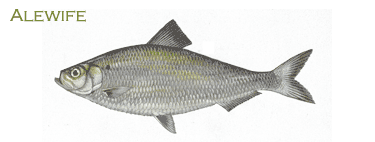
Alewives are anadromous fish , living in saltwater and seasonally returning to freshwater to spawn. Throughout most of the year they travel the coast in large schools, foraging on plankton. Then, in the spring, they run up coastal streams and rivers toward ponds and lakes where they spawn. Because they are not jumpers, manmade or natural barriers sometimes block their spawning migration. The historical distribution of this species is throughout the Atlantic Seaboard, from Newfoundland to South Carolina. Alewives are an iridescent gray green or violet shade on top that fades down their sides to a silvery underbelly. They usually have a distinct dusky spot just behind the upper margin of their gill cover. Adult alewives normally grow to be 10 to 11 inches in length and 8 to 9 ounces in weight. In the 1970’s, the alewife was the most valuable commercial anadromous fishery in Maine with commercial harvest exceeding 3.4 million pounds annually. Today, landings are less than 1.0 million pounds.
Alewives are important to the ecology of the freshwater, estuarine, and marine environment. The adults and young provide a food source for striped bass, brown trout, salmonid species, eels, ospreys, eagles, kingfishers, cormorants, and aquatic furbearing mammals. Adult alewives are a preferred bait for the spring lobster fishery. There are 35 Maine municipalities that have commercial harvesting rights to alewives on 39 coastal streams and rivers. These runs provide revenue to the towns, which lease their fishing privileges to independent fishermen. Many of the fishways built for alewife restoration on some of our small coastal streams were partially funded by these municipalities as they recognized the value of this native species. Since the early 1970’s, over 12 million dollars of state, federal, and private utility funds have been spent on fish passage to restore runs of alewives, Atlantic Salmon, and American Shad to historic spawning areas.
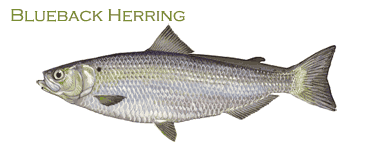
Blueback Herring are grey green to blue on top, which fades down their sides to a silver underbelly. On average, blueback herring grow to be 10 to 11 inches in length and 9 to 9 ounces in weight. Like their relatives the alewives, blueback herring are anadromous, living in saltwater and returning to freshwater to spawn. They travel along the coast in large schools, feeding on plankton for most of the year. In spring, bluebacks run up coastal streams and rivers to spawn, usually toward the end of the alewife run in late May and June. Blueback herring, unlike the alewife, will spawn in a river habitat rather than lakes or ponds.
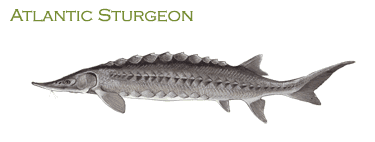 Atlantic Sturgeon are olive green or blue gray, gradually fading on the sides to a white underbelly. Atlantic sturgeon are primitive looking fish that are best known for the caviar (fish eggs) they produce. Large, slow-to-mature fish, they can grow to 18 feet in length and are designed to be effective bottom feeders. Being anadromous in nature, they return to their native rivers to spawn. Most of their growth is believed to occur out at sea where they feed on various invertebrates and small fish. In Maine waters, law protects both the Atlantic sturgeon and the shortnose sturgeon.
Atlantic Sturgeon are olive green or blue gray, gradually fading on the sides to a white underbelly. Atlantic sturgeon are primitive looking fish that are best known for the caviar (fish eggs) they produce. Large, slow-to-mature fish, they can grow to 18 feet in length and are designed to be effective bottom feeders. Being anadromous in nature, they return to their native rivers to spawn. Most of their growth is believed to occur out at sea where they feed on various invertebrates and small fish. In Maine waters, law protects both the Atlantic sturgeon and the shortnose sturgeon.
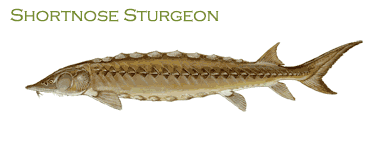 Shortnose Sturgeon are a federally endangered freshwater fish. They are primitive fish with rows of boney, armor-like plates on their sides and a skeleton of cartilage rather than bones. Sturgeon are bottom feeders; they suck plants and animals disturbed by their movement into their tube-like mouth. Smaller than their cousins the Atlantic Sturgeon, which can grow to 18 feet long, the shortnose sturgeon rarely grows more than 4 feet in length.
Shortnose Sturgeon are a federally endangered freshwater fish. They are primitive fish with rows of boney, armor-like plates on their sides and a skeleton of cartilage rather than bones. Sturgeon are bottom feeders; they suck plants and animals disturbed by their movement into their tube-like mouth. Smaller than their cousins the Atlantic Sturgeon, which can grow to 18 feet long, the shortnose sturgeon rarely grows more than 4 feet in length.
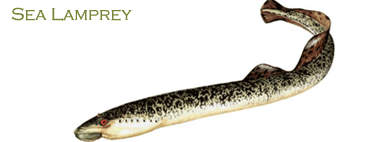 Sea Lamprey. The most misunderstood native fish of the Penobscot. Juvenile lamprey live for up to eight years in freshwater, eating organic debris, and live in saltwater for two years before returning to the Penobscot to spawn in late May and early June where they dig nests in shallow gravel beds of the river. Like Pacific salmon, sea lamprey die immediately after spawning and their carcasses provide important nutrients to local stream environments.
Sea Lamprey. The most misunderstood native fish of the Penobscot. Juvenile lamprey live for up to eight years in freshwater, eating organic debris, and live in saltwater for two years before returning to the Penobscot to spawn in late May and early June where they dig nests in shallow gravel beds of the river. Like Pacific salmon, sea lamprey die immediately after spawning and their carcasses provide important nutrients to local stream environments.
Catadromous fish spawn in the ocean and migrate to fresh water to grow to adult size such as the American Eel.
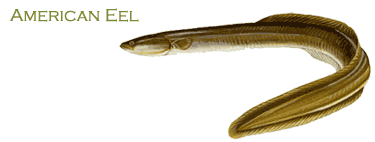 American Eel. As adult eels mature, they leave the brackish/freshwater growing areas in the fall (August to November), migrate to the Sargasso Sea and spawn during the winter. The Sargasso Sea is a large area of the western North Atlantic located east of the Bahamas and south of Bermuda. After spawning the adult eel dies. The eggs hatch after several days and develop into a larval stage that drifts through the ocean for several months until they enter the Gulf Stream current to be carried north towards the North American continent. As the larvae approach the continental shelf, the larvae transform into miniature transparent eels called “glass eels.” As glass eels leave the open ocean and enter into estuaries they are know as elvers. With each life stage of the eel there is a commercial fishery that impacts not only eel populations but also other species including salmon, alewives, smelt and trout. This migration begins in late winter and continues through the summer months. Eels may stay in growing areas from 8-25 years before migrating back to sea to spawn.
American Eel. As adult eels mature, they leave the brackish/freshwater growing areas in the fall (August to November), migrate to the Sargasso Sea and spawn during the winter. The Sargasso Sea is a large area of the western North Atlantic located east of the Bahamas and south of Bermuda. After spawning the adult eel dies. The eggs hatch after several days and develop into a larval stage that drifts through the ocean for several months until they enter the Gulf Stream current to be carried north towards the North American continent. As the larvae approach the continental shelf, the larvae transform into miniature transparent eels called “glass eels.” As glass eels leave the open ocean and enter into estuaries they are know as elvers. With each life stage of the eel there is a commercial fishery that impacts not only eel populations but also other species including salmon, alewives, smelt and trout. This migration begins in late winter and continues through the summer months. Eels may stay in growing areas from 8-25 years before migrating back to sea to spawn.











